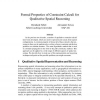Free Online Productivity Tools
i2Speak
i2Symbol
i2OCR
iTex2Img
iWeb2Print
iWeb2Shot
i2Type
iPdf2Split
iPdf2Merge
i2Bopomofo
i2Arabic
i2Style
i2Image
i2PDF
iLatex2Rtf
Sci2ools
KI
2002
Springer
2002
Springer
Formal Properties of Constraint Calculi for Qualitative Spatial Reasoning
In the previous two decades, a number of qualitative constraint calculi have been developed, which are used to represent and reason about spatial configurations. A common property of almost all of these calculi is that reasoning in them can be understood as solving a binary constraint satisfaction problem over infinite domains. The main algorithmic method that is used is constraint propagation in the form of the path-consistency method. This approach can be applied to a wide range of different aspects of spatial reasoning. We describe how to make use of this representation and reasoning technique and point out the possible problems one might encounter. 1 Qualitative Spatial Representation and Reasoning Representing spatial information and reasoning about this information is an important subproblem in many applications, such as geographical information systems (GIS), natural language understanding, robot navigation, and document interpretation. Often this information is only available ...
Related Content
| Added | 22 Dec 2010 |
| Updated | 22 Dec 2010 |
| Type | Journal |
| Year | 2002 |
| Where | KI |
| Authors | Bernhard Nebel, Alexander Scivos |
Comments (0)

